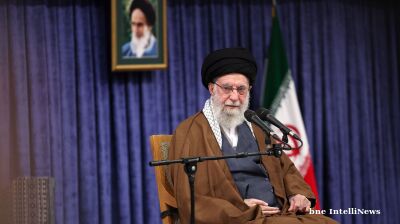Russia has redeployed 30,000 troops to Kursk as the counter-offensive to Ukraine’s incursion gathers momentum, said Ukraine’s commander-in-chief, Oleksandr Syrskyi, speaking at the "Ukraine 2024. Independence" forum in Kyiv on August 27, the Kyiv Independent reports.
Ukraine’s ongoing offensive in Russia’s Kursk Oblast has successfully diverted a significant number of Russian forces from other critical fronts, according to Syrskyi. Moscow has redeployed approximately 30,000 troops to the Kursk region Ukraine's incursion that began on August 6. The number of transferred soldiers is continuing to grow, according to Syrskyi, without saying where the troops were redeployed from.
Ukrainian forces have reportedly secured control over 1,294 square kilometres of territory, including 100 settlements such as the strategically important town of Sudzha, home to the gas metering station that supplies Europe with Russian gas.
Syrskyi also claimed that Ukrainian forces have captured 594 Russian soldiers during the campaign.
"The enemy is trying to withdraw units from other directions, and on the contrary, it is increasing its efforts in the Pokrovsk sectors," Syrskyi said during the forum. While the Armed Forces of Ukraine (AFU) has been marauding in Kursk, facing little opposition as the incursion goes into its fourth week, the Armed Forces of Russia (AFR) are making steady progress towards taking the Ukrainian town of Pokrovsk, of 60,000 residents and a key logistical hub that supplies Ukraine’s forces on the front line.
The key question of where the fresh Russian troops are coming from was not addressed. One of the hopes of the incursion was to relieve the pressure on the AFU defenders on the front line in the battle for Donbas, but it appears that the Kremlin has not weakened its forces in the Donbas to bolster the forces facing the AFU in Kursk.
As bne IntelliNews reported, Russia has formed a new battle group to counter the incursion in the three regions on Ukraine’s border of Bryansk, Belgorod and Kursk, but it has drawn on reservists in these regions, and brought some from outside, from Kaliningrad for example, but has not withdrawn more than a few units from Donbas.
In what some are calling a strategic blunder, instead of weakening Russia’s forces on the Donbas front line, Kyiv has weakened its own forces there by withdrawing some of its best units for the Donbas incursion. The number of troops in the Ukrainian expeditionary force remains unclear but reported estimates run from 7,000 to 20,000, with 12,000 being the most often cited number.
Separately, Zelenskiy said the occupation of the Kharkiv Region had been halted by the Kursk operation. Ukraine had information that Russia intended to create buffer zones in Kharkiv Oblast and then in the north (Sumy and Chernihiv Oblasts). It was possible to prevent this and break up a sizable grouping of Russian troops, according to Zelenskiy. The enemy transferred a portion of its troops from Kharkiv and Zaporizhzhia to the Kursk region, but he admitted that Russia considers the Donetsk region to be a strategic area and kept its most prepared units there.
Syrskyi admitted that Russia has also deployed some of its most combat-ready units to the Pokrovsk sector in Donetsk Oblast despite the reinforcements being sent to Kursk, where the defence by the AFU is slowly starting to crumble, according to battlefield reports. If the strategy was to weaken Russia’s assault on Pokrovsk, then Syrskyi’s comments suggest that strategy has failed.
Despite the apparent success in Kursk, Syrskyi noted that Russia continues to advance in certain areas. In Zaporizhzhia Oblast, Russian forces are attempting to regain positions near the village of Robotyne, while in the partially occupied Kherson Oblast, Moscow's troops are striving to reassert control over an island zone near the Dnipro River's delta, Kyiv Independent reports.
"The enemy’s activity has reduced in Ukraine's south, but they continue to advance in Zaporizhzhia Oblast," Syrskyi reported, reflecting Russia's broader strategy to maintain pressure on multiple fronts, even as it grapples with the need to respond to Ukraine’s unexpected advances in Kursk.
Russia appears to be in no rush to take Kursk back, having said that it will take “months” to eject the AFU and that the public should be prepared for a “new normal” as the counter offensive gathers momentum. The AFU’s advance in Kursk is reportedly slowing as the new troops arrive as a new frontline in Kursk crystallises. There are unconfirmed reports of “positional” fighting beginning as the Russian troops dig in and prepare new defensive positions, especially around the Kursk nuclear power plant (NPP) that is some 30 km from the fighting. Russian President Vladimir Putin has set a deadline to clear the region of attacking Ukrainian troops by October 1.
As Ukraine’s Independence Day celebrations on August 27 draw to a close, the country’s military leadership remains focused on consolidating recent gains and maintaining momentum in its broader counteroffensive, the Kyiv Independent reports.
News
_2_1761012864.jpg)
India’s opposition slams Modi over Trump’s Russia oil claim
Indian National Congress leader Jairam Ramesh in an X post criticised Prime Minister Narendra Modi for staying silent over US President Donald Trump’s repeated claims that India would cut back on oil imports from Russia.
_Cropped_(1).jpg)
Colombia pulls ambassador from Washington as Trump threatens tariffs
Colombia has recalled its ambassador from Washington after President Donald Trump branded President Gustavo Petro an "illegal drug leader" and pledged to halt all financial assistance whilst threatening enhanced tariffs.

Top US military officer for Latin America quits amid Venezuela tensions
The head of the Pentagon's Southern Command is to step down at the end of the year amid mounting tensions over the Trump administration's military operations in the Caribbean targeting alleged Venezuelan drug traffickers

Iran's Khamenei calls Trump a 'real terrorist'
Iran's Supreme Leader Khamenei tells Trump "what business is it of yours" regarding nuclear industry, calling US president's positions lies and bullying whilst rejecting claims of supporting Iranian people.
-fotor-bg-remover-20251020114620.png)



